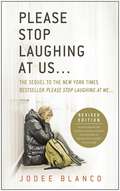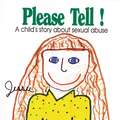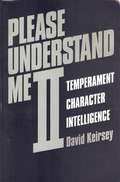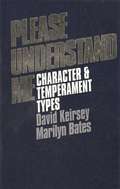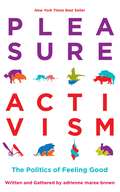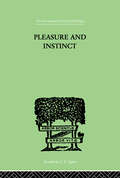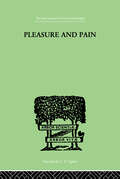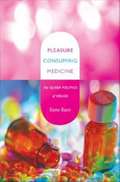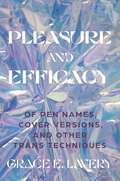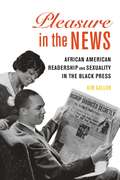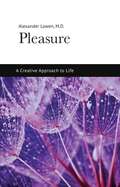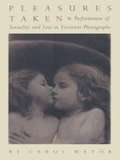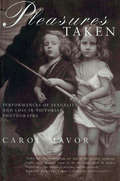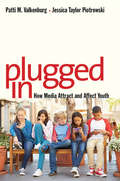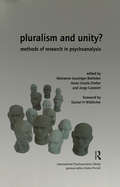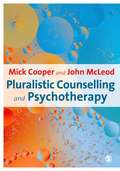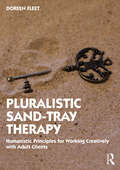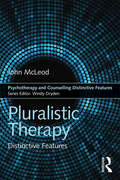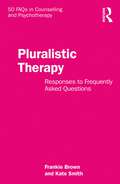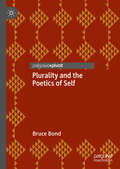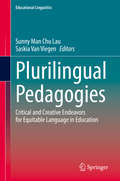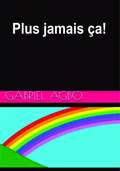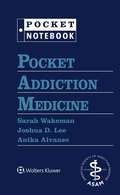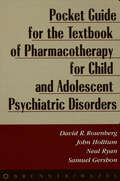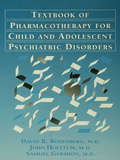- Table View
- List View
Please Stop Laughing at Us... (Revised Edition): The Sequel to the New York Times Bestseller Please Stop Laughing at Me...
by Jodee BlancoAs a sequel to the New York Times bestseller Please Stop Laughing at Me..., the 2007 release of Jodee Blanco's Please Stop Laughing at Us... received deserved attention for demanding an end to school bullying once and for all, and for supplying parents, educators, and targeted students with the tools and skills needed to do so. In this 2011 revised edition, Please Stop Laughing at Us...One Woman's Inspirational Story Continues includes the same powerful message that Blanco is respected and known for, with new material, including strategy guides for parents and educators, new material, including a Q&A for parents and educators, updated information on university bullying in light of recent news events, and a touching epilogue. Please Stop Laughing at Us...is the story of America's rejected and bullied students from the perspective of the one person with unprecedented access to the truth about what's going on in our schools. Blanco exposes both the strengths and vulnerabilities of a nation too clouded by rhetoric and self-defense to understand what really needs to be done.
Please Tell: A Child's Story About Sexual Abuse
by JessieWritten and illustrated by a girl who was sexually molested by a family member, this book reaches out to other children by carrying Jessie’s message “It's o.k. to tell; help can come when you tell."Written and illustrated by a young girl who was sexually molested by a family member, this book reaches out to other children in a way that no adult can, Jessie's words carry the message, "It's o.k. to tell; help can come when you tell."This book is an excellent tool for therapists, counselors, child protection workers, teachers, and parents dealing with children affected by sexual abuse.Jessie's story adds a sense of hope for what should be, and the knowledge that the child protection system can work for children. Simple, direct, and from the heart, Jessie gives children the permission and the courage to deal with sexual abuse."Please Tell! is a beautifully simple book with a profoundly important message for children who have been sexually abused: the abuse wasn't their fault. Written and illustrated by Jessie, herself a pre-teen survivor of sexual abuse, it tells kids just what to do to get the help they need." Kristin A. Kunzman, abuse therapist and author of The Healing Way: Adult Recovery from Childhood Sexual Abuse
Please Understand Me II:Temperament, Character, Intelligence
by David KeirseyFor the past twenty years Keirsey has continued to investigate personality differences -- to refine his theory of the four temperaments and to define the facets of character that distinguish one from another. His findings form the basis of Please Understand Me II, an updated and greatly expanded edition of the book, far more comprehensive and coherent than the original, and yet with much of the same easy accessibility. One major addition is Keirsey's view of how the temperaments differ in the intelligent roles they are most likely to develop. Each of us, he says, has four kinds of intelligence - tactical, logistical, diplomatic, strategic - though one of the four interests us far more than the others, and thus gets far more practice than the rest. Like four suits in a hand of cards, we each have a long suit and a short suit in what interests us and what we do well, and fortunate indeed are those whose work matches their skills. As in the original book, Please Understand Me II begins with The Keirsey Temperament Sorter, the most used personality inventory in the world. But also included is The Keirsey Four-Types Sorter, a new short questionnaire that identifies one's basic temperament and then ranks one's second, third, and fourth choices. Share this new sorter with friends and family, and get set for a lively and fascinating discussion of personal styles.
Please Understand Me: Character & Temperament Types
by David Keirsey Marilyn BatesWe are different for a reason, and that reason is probably more good than bad. Keirsey and Bates believe that not only is it impossible to truly change others (which they call embarking on a "Pygmalion project"), it's much more important to understand and affirm differences.
Pleasure Activism: The Politics Of Feeling Good (Emergent Strategy Ser.)
by Leah Lakshmi Piepzna-Samarasinha Adrienne Maree Brown Favianna RodriguezHow do we make social justice the most pleasurable human experience? How can we awaken within ourselves desires that make it impossible to settle for anything less than a fulfilling life? Author and editor adrienne maree brown finds the answer in something she calls "pleasure activism," a politics of healing and happiness that explodes the dour myth that changing the world is just another form of work. Drawing on the black feminist tradition, she challenges us to rethink the ground rules of activism. Her mindset-altering essays are interwoven with conversations and insights from other feminist thinkers, including Audre Lorde, Joan Morgan, Cara Page, Sonya Renee Taylor, and Alexis Pauline Gumbs. Together they cover a wide array of subjects--from sex work to climate change, from race and gender to sex and drugs--building new narratives about how politics can feel good and how what feels good always has a complex politics of its own.
Pleasure And Instinct: A STUDY IN THE PSYCHOLOGY OF HUMAN ACTION (International Library Of Psychology)
by Allen, A H BurltonFirst Published in 1999. Routledge is an imprint of Taylor & Francis, an informa company.
Pleasure And Pain: A Theory of the Energic Foundation of Feeling (International Library Of Psychology Ser.)
by Bousfield, PaulFirst Published in 1999. Routledge is an imprint of Taylor & Francis, an informa company.
Pleasure Consuming Medicine: The Queer Politics of Drugs
by Kane RaceOn a summer night in 2007, the Azure Party, part of Sydney's annual gay and lesbian Mardi Gras, is underway. Alongside the party outfits, drugs, lights, and DJs is a volunteer care team trained to deal with the drug-related emergencies that occasionally occur. But when police appear at the gates with drug-detecting dogs, mild panic ensues. Some patrons down all their drugs, heightening their risk of overdose. Others try their luck at the gates. After twenty-six attendees are arrested with small quantities of illicit substances, the party is shut down and the remaining partygoers disperse into the city streets. For Kane Race, the Azure Party drug search is emblematic of a broader technology of power that converges on embodiment, consumption, and pleasure in the name of health. In Pleasure Consuming Medicine, he illuminates the symbolic role that the illicit drug user fulfills for the neoliberal state. As he demonstrates, the state's performance of moral sovereignty around substances designated "illicit" bears little relation to the actual dangers of drug consumption; in fact, it exacerbates those dangers. Race does not suggest that drug use is risk-free, good, or bad, but rather that the regulation of drugs has become a site where ideological lessons about the propriety of consumption are propounded. He argues that official discourses about drug use conjure a space where the neoliberal state can be seen to be policing the "excesses" of the amoral market. He explores this normative investment in drug regimes and some "counterpublic health" measures that have emerged in response. These measures, which Race finds in certain pragmatic gay men's health and HIV prevention practices, are not cloaked in moralistic language, and they do not cast health as antithetical to pleasure.
Pleasure and Efficacy: Of Pen Names, Cover Versions, and Other Trans Techniques
by Grace Elisabeth LaveryA leading trans scholar and activist explores cultural representations of gender transition in the modern periodIn Pleasure and Efficacy, Grace Lavery investigates gender transition as it has been experienced and represented in the modern period. Considering examples that range from the novels of George Eliot to the psychoanalytic practice of Sigmund Freud to marriage manuals by Marie Stopes, Lavery explores the skepticism found in such works about whether it is truly possible to change one’s sex. This ambivalence, she argues, has contributed to both antitrans oppression and the civil rights claims with which trans people have confronted it. Lavery examines what she terms “trans pragmatism”—the ways that trans people resist medicalization and pathologization to achieve pleasure and freedom. Trans pragmatism, she writes, affirms that transition works, that it is possible, and that it happens.With Eliot and Freud as the guiding geniuses of the book, Lavery covers a vast range of modern culture—poetry, prose, criticism, philosophy, fiction, cinema, pop music, pornography, and memes. Since transition takes people out of one genre and deposits them in another, she suggests, it should be no surprise that a cultural history of gender transition will also provide, by accident, a history of genre transition. Considering the concept of technique and its associations with feminine craftiness, as opposed to masculine freedom, Lavery argues that techniques of giving and receiving pleasure are essential to the possibility of trans feminist thriving—even as they are suppressed by patriarchal and antitrans feminist philosophies. Contesting claims for the impossibility of transition, she offers a counterhistory of tricks and techniques, passed on by women to women, that comprises a body of knowledge written in the margins of history.
Pleasure in the News: African American Readership and Sexuality in the Black Press (New Black Studies Series #1)
by Kim GallonCritics often chastised the twentieth-century black press for focusing on sex and scandal rather than African American achievements. In Pleasure in the News, Kim Gallon takes an opposing stance—arguing that African American newspapers fostered black sexual expression, agency, and identity. <P><P> Gallon discusses how journalists and editors created black sexual publics that offered everyday African Americans opportunities to discuss sexual topics that exposed class and gender tensions. While black churches and black schools often encouraged sexual restraint, the black press printed stories that complicated notions about respectability. Sensational coverage also expanded African American women’s sexual consciousness and demonstrated the tenuous position of female impersonators, black gay men, and black lesbians in early twentieth African American urban communities. <P><P> Informative and empowering, Pleasure in the News redefines the significance of the black press in African American history and advancement while shedding light on the important cultural and social role that sexuality played in the power of the black press.
Pleasure: A Creative Approach to Life
by Alexander LowenIn Pleasure: A Creative Approach to Life, Alexander Lowen shows how the experience of pleasure or pain determines our emotions, thinking, and behavior. Lowen views the body as the outer manifestation of the spirit and defines grace as the divine spirit acting within the body. For the healthy individual the divine spirit is experienced as the natural gracefulness of the body and is reflected in the person's behavior. In a healthy body, movement, feeling, and thinking are integrated in grace and harmony. This book includes body-psychotherapy techniques and exercises aimed at alleviating muscular tension and restoring the body's natural grace. This spiritual grace involves a sense of connectedness to a higher order. In this state of grace we feel a kinship with all living creatures, and recognize our connection to our environment and to the world.
Pleasures Taken: Performances of Sexuality and Loss in Victorian Photographs
by Carol MavorAn intimate look into three Victorian photo-settings, Pleasures Taken considers questions of loss and sexuality as they are raised by some of the most compelling and often misrepresented photographs of the era: Lewis Carroll's photographs of young girls; Julia Margaret Cameron's photographs of Madonnas; and the photographs of Hannah Cullwick, a "maid of all work," who had herself pictured in a range of masquerades, from a blackened chimney sweep to a bare-chested Magdalene. Reading these settings performatively, Carol Mavor shifts the focus toward the subjectivity of these girls and women, and toward herself as a writer.Mavor's original approach to these photographs emphatically sees sexuality where it has been previously rendered invisible. She insists that the sexuality of the girls in Carroll's pictures is not only present, but deserves recognition, respect, and scrutiny. Similarly, she sees in Cameron's photographs of sensual Madonnas surprising visions of motherhood that outstrip both Victorian and contemporary understandings of the maternal as untouchable and inviolate, without sexuality. Finally she shows how Hannah Cullwick, posing in various masquerades for her secret paramour, emerges as a subject with desires rather than simply a victim of her upper-class partner. Even when confronting the darker areas of these photographs, Mavor perseveres in her insistence on the pleasures taken--by the viewer, the photographer, and often by the model herself--in the act of imagining these sexualities. Inspired by Roland Barthes, and drawing on other theorists such as Julia Kristeva and Luce Irigaray, Mavor creates a text that is at once interdisciplinary, personal, and profoundly pleasurable.
Pleasures Taken: Performances of Sexuality and Loss in Victorian Photographs
by Carol MavorLewis Carroll's photographs of young girls, Julia Margaret Cameron's photographs of Madonnas and the photographs of Hannah Cullwick, "maid of all work", pictured in masquerade - Carol Mavor addresses the erotic possibilities of these images, exploring not ony the sexualities of the girls, maids and Madonnas, but the pleasures taken - by the viewer, the photographer, the model - in imagining these sexualities.
Plugged In: How Media Attract and Affect Youth
by Jessica Taylor Piotrowski Patti M. ValkenburgAn illuminating study of the complex relationship between children and media in the digital age Now, as never before, young people are surrounded by media—thanks to the sophistication and portability of the technology that puts it literally in the palms of their hands. Drawing on data and empirical research that cross many fields and continents, authors Valkenburg and Piotrowski examine the role of media in the lives of children from birth through adolescence, addressing the complex issues of how media affect the young and what adults can do to encourage responsible use in an age of selfies, Twitter, Facebook, and Instagram. This important study looks at both the sunny and the dark side of media use by today’s youth, including why and how their preferences change throughout childhood, whether digital gaming is harmful or helpful, the effects of placing tablets and smartphones in the hands of toddlers, the susceptibility of young people to online advertising, the legitimacy of parental concerns about media multitasking, and more.
Pluralism and Unity?: Methods of Research in Psychoanalysis
by Jorge CanestriThis book compiles the papers presented at an International Conference, "Pluralism of Sciences: The Psychoanalytic Method between Clinical, Conceptual and Empirical Research" in 2002. It provides the variety and diversity of psychoanalytic research cultures in different psychoanalytic societies.
Pluralistic Counselling and Psychotherapy: Distinctive Features (Psychotherapy And Counselling Distinctive Features Ser.)
by Mick Cooper John McLeodMick Cooper and John McLeod pioneer a major new framework for counselling theory, practice and research - the ′pluralistic′ approach. This model breaks away from the orientation-specific way in which counselling has traditionally been taught, reflecting and responding to shifts in counselling and psychotherapy training. As accessible and engaging as ever, Cooper and McLeod argue that there is no one right way of doing therapy and that different clients need different things at different times. By identifying and demonstrating the application of a range of therapeutic methods, the book outlines a flexible framework for practice within which appropriate methods can be selected depending on the client′s individual needs and the therapist′s knowledge and experience. This is a must-read for anybody training or practising in the counselling or helping professions - it should not be missed!
Pluralistic Sand-Tray Therapy: Humanistic Principles for Working Creatively with Adult Clients
by Doreen FleetIn this book, Fleet provides the first comprehensive guide to implementing sand-tray therapy within a pluralistic framework. Pluralistic Sand-Tray Therapy offers several unique contributions to a theoretical understanding of the therapeutic process, including the dynamic phenomenological field incorporating the concept of phenomenological shift and the introduction to two sand-tray specific mechanisms that aid the therapeutic process by facilitating the client’s discovery in a unique way. Theory is applied to practice with step-by-step detailed guidance on how to deliver effective pluralistic sand-tray therapy from the initial appointment to the end of therapy. Each theoretical concept and practical direction is supported by case study findings, including photographs taken during real sessions. This book will be an essential text for academics and students of psychotherapy and counselling seeking to understand the impact and implementation of sand-tray therapy. It also offers a complete guide for practicing counsellors and psychotherapists, including arts and play therapists, who wish to use sand-tray therapy in their work.
Pluralistic Therapy: Distinctive Features (Psychotherapy and Counselling Distinctive Features)
by John McLeodPluralistic Therapy: Distinctive Features offers an introduction to what is distinctive about this increasingly popular method. Written by one of the co-founders of pluralistic therapy, and a leading UK figure in counselling and psychotherapy, this book describes 15 theoretical features and 15 practical techniques for practitioners. Pluralistic therapy is a flexible, integrative approach to counselling and psychotherapy, which has also found applications in fields such as mental health, life coaching and careers guidance. Pluralistic Therapy: Distinctive Features will provide an essential guide to students and practitioners of psychotherapy, or an allied area of practice, who are open to learning about new ideas and techniques from current interdisciplinary research.
Pluralistic Therapy: Responses to Frequently Asked Questions (50 FAQs in Counselling and Psychotherapy)
by Kate Smith Frankie BrownPluralistic Therapy provides answers to the most important and common questions asked about the origins, principles and practice of pluralism. Written in an accessible style by experts in the field, the book provides the reader with a comprehensive understanding of the pluralistic approach in theory and practice, and builds on the contemporary developments in the field. The questions cover five areas, including an overview of pluralism, pluralism in practice, client factors, pluralistic developments outside of individual therapy and critical questions about pluralism. The questions also cover some of the key challenges posed to the approach. This book will appeal to a wide range of audiences, including therapeutic practitioners, researchers, and professionals interested in the application of the approach within mental health contexts. It will also serve to help professionals from non-therapy backgrounds such as mental health services, education, and social care understand the nature of pluralistic work.
Plurality and the Poetics of Self
by Bruce BondPlurality and the Poetics of Self investigates the words “I” and “self” as suggestive of eight territories of meaning. Via poetry’s lens into language and its limits, Bruce Bond explores the notion of self as identity, volitional agent, ego, existential monad, subjectivity, ontological origin, soul, and transpersonal psyche. Taking poetic meaning as our common currency, the book emphasizes the critical role of the un-representable and how embattled and confused assumptions threaten ever deeper alienation from one another and ourselves.
Plurilingual Pedagogies: Critical and Creative Endeavors for Equitable Language in Education (Educational Linguistics #42)
by Sunny Man Chu Lau Saskia Van ViegenThis book critically engages with theoretical shifts marked by the ‘multilingual turn’ in applied linguistics, and articulates the complexities associated with naming and engaging with the everyday language practices of bi/multilingual communities. It discusses methodological approaches that enable researchers and educators to observe and interact with these communities and to understand their teaching and learning needs. It also highlights pedagogical approaches and instructional strategies involved with learning and teaching language and/or content curriculum to students across various learning and educational contexts. The book addresses recent debates on the multi/plural turn in applied linguistics and articulates the limitations of these debates - particularly the absence of discussion of social power relations and contexts in applying different theoretical lenses. It features empirical research from primarily North American classrooms to highlight how plurilingual pedagogies take shape in unique educational contexts, resisting monolingual approaches to language in education. Furthermore, it includes commentary/response pieces from established scholars in dialogue with recent plurilingual research in the field, to put the work in critical perspective within extant theories and literature.
Plus jamais ça!
by Gabriel Agbo«Le SEIGNEUR dit:« Je vous rendrai ce que vous avez perdu aux criquets pèlerins, aux criquets pèlerins, aux criquets grouillants et aux sauterelles sautillantes… Jamais plus mon peuple ne sera déshonoré comme ça. Alors vous saurez que je suis ici parmi mon peuple d'Israël et que je suis seul l'Éternel, votre Dieu. Mon peuple ne sera plus jamais déshonoré comme ça. » Joël 2: 25-27 Il est temps d'arrêter ces choses qui veulent vous arrêter. C'est la volonté de Dieu d'arrêter tout ce qui veut vous retirer de ses plans pour votre vie. Et vous savez déjà que son plan pour vous est d'avoir le meilleur de la joie, de la paix, de la prospérité, de la miséricorde, de la bonne santé et de posséder tous vos biens. Même si vous êtes sous son jugement, il peut être inversé aujourd'hui et vous recommencerez à nager dans sa grâce. Nous avons également examiné les expériences des autres et la version israélienne moderne de Never Again. Pourquoi ont-ils adopté ce slogan et jusqu'où sont-ils allés pour le faire respecter? Bien sûr, Israël est devenu aujourd'hui l'une des nations les plus puissantes sur terre (Il a la meilleure organisation intelligente - le Mossad et la troisième meilleure armée du monde) non seulement parce que Dieu est avec eux, mais parce qu'ils ont également juré de ne jamais permettre Les Juifs subissent les traitements, les douleurs, la tristesse et les morts les plus déshumanisants qu'ils ont connus lors des événements malheureux et évitables du siècle dernier. Aujourd'hui, ils mènent non seulement la défense, mais aussi l'agriculture, les TIC, la science et la médecine. Oui, nous pouvons dire plus jamais aujourd'hui! Ce livre est certainement une lecture intéressante. «Le SEIGNEUR dit:« Je vous rendrai ce que vous avez perdu aux criquets pèlerins, aux criquets pèlerins, aux criquets grouillants et aux sauterelles sautillantes… Jamais plus mon peuple ne sera désho
Pocket Addiction Medicine (Pocket Notebook Series)
by Joshua D. Lee Sarah E. Wakeman Anika A.H. AlvanzoA new volume in the bestselling Pocket Notebook series, Pocket Addiction Medicine delivers highly relevant coverage of this widespread and increasing health care problem in an easily portable source. Edited by physician leaders in Addiction Medicine, Drs. Sarah E. Wakeman, Joshua D. Lee, and Anika Alvanzo and co-published with the American Society of Addiction Medicine (ASAM), this handbook provides must-know information on everything from screening for and diagnosis of substance use disorder to managing intoxication and withdrawal, to ongoing treatment of substance use disorder, including caring for special populations—all designed for quick reference at the point of care. Using the popular, easy-access Pocket Notebook format, it puts key clinical information about a broad range of issues in addiction medicine at your fingertips in seconds.
Pocket Guide For Textbook Of Pharmocotherapy
by David Rosenberg Samuel Gershon John Holttum Neal RyanThe Pocket Guide for the Textbook of Pharmacotherapy for Child and Adolescent Psychiatric Disorders is a quick reference guide for psychiatrists, therapists, social workers, and other practitioners to give them the bottom line about each group of medications. This guide, which discusses the use of psychiatric drugs in patients under 18, accompanies this author team's complete book, Textbook of Pharmacotherapy for Child and Adolescent Psychiatric Disorders.Clinical indications, dosage guidelines, side effects, common drug interactions and most tables are retained and updated in this new guide. In addition, the guide includes new research findings that have been published recently. This guide assumes the reader has done a complete assessment of all non-pharmacologic methods before treating the patient with medication. It also assumes that the reader has a working knowledge of the types of medication available for treating psychiatric illnesses. Once everything is taken into account, the practitioner can accurately determine the advantages and disadvantages of a specific treatment and relay that to the patient. Above all, the Pocket Guide for the Textbook of Pharmacotherapy for Child and Adolescent Psychiatric Disorders provides the reader with the practical guidelines to safely and effectively prescribe medication.
Pocket Guide For The Textbook Of Pharmacotherapy For Child And Adolescent psychiatric disorders
by David RosenbergThis is a quick-reference guide for psychiatrists, therapists, social workers, and other practitioners about each group of medications. This guide, which discusses the use of psychiatric drugs in patients under 18, accompanies the author team's complete book Textbook of Pharmacotherapy for Child and Adolescent Psychiatric Disorders.; Clinical indications, dosage guidelines, side-effects, common drug interactions and most tables are retained and updated in this guide. the guide provides the reader with the practical guidelines to safely and effectively prescribe medication.
